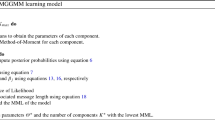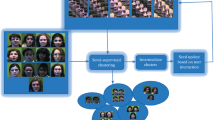Abstract
This paper presents a new technique of unified probabilistic models for face recognition from only one single example image per person. The unified models, trained on an obtained training set with multiple samples per person, are used to recognize facial images from another disjoint database with a single sample per person. Variations between facial images are modeled as two unified probabilistic models: within-class variations and between-class variations. Gaussian Mixture Models are used to approximate the distributions of the two variations and exploit a classifier combination method to improve the performance. Extensive experimental results on the ORL face database and the authors' database (the ICT-JDL database) including totally 1,750 facial images of 350 individuals demonstrate that the proposed technique, compared with traditional eigenface method and some well-known traditional algorithms, is a significantly more effective and robust approach, for face recognition.
Similar content being viewed by others
References
Wiskott Laurenz, Fellous Jean-Marc, Norbert Krugeret al., Face recognition by elastic bunch graph matching.IEEE Trans. Pattern Analysis and Machine Intelligence, 1997, 19(7): 775–779.
Cootes T F, Taylor C J. Active shape model search using local grey-level models: A quantitative evaluation.British Machine Vision Conference, 1993.
Lanitis A, Taylor C J, Cootes T F, Automatic interpretation and coding of face images using flexible models.IEEE Trans. Pattern Analysis and Machine Intelligence, 1997, 19(7): 743–756.
Cootes T F, Edwards G J, Taylor C J. Active appearance models.IEEE European Conf. Computer Vision, 1998.
Penev P, Atick J. Local feature analysis: A general statistical theory for object representation.Network: Computation in Neural Systems, 1996, 7(3): 477–500.
Turk M, Pentland A. Eigenfaces for recognition.Journal of Cognitive Neuroscience, 1991, 3(1): 71–86.
Belhumeur P N, Hespanha J P, Kriegman D J. Eigenfaces vs. fisherfaces: Recognition using class specific linear projection.IEEE Trans. Pattern Analysis and Machine Intelligence, 1997, 19(7): 711–720.
Swets D L, Weng J. Using discriminant eigenfeatures for image retrieval.IEEE Trans. Pattern Analysis and Machine Intelligence, 1996, 18(8): 831–836.
Etemad K, Chellappa R. Discriminant analysis for recognition of human face images.Journal of the Optical Society of America, 1997, 14: 1723–1733
Martinez A M, Kak A C. PCA versus LDA.IEEE Trans. Pattern Analysis and Machine Intelligence, 2001, 23(2): 228–233.
Philips P Jonathon. Support Vector Machines Applied to Face Recognition. InAdvances in Neural Information Processing Systems II, Kearns M J, Solla S A, Cohn D A (eds.), MIT Press, 1999.
Li Y, Gong S, Liddell H. Support vector regression and classification based multi-view face detection and recognition.IEEE International Conference on Automatic Face and Gesture Recognition, 2000.
Johnsson K, Kittler J, Li Y, Matas J. Support vector machines for face authentication.British Machine Vision Conference, 1999.
Liu Qingshan, Huang Rui, Lu Hanqinget al. Face recognition using kernel based Fisher discriminant analysis.IEEE International Conference on Automatic Face and Gesture Recognition, 2002.
Yang Ming-Hsuan, Ahuja Narendra, Kriegman David. Face recognition using kernel eigenfaces.IEEE International Conference on Image Processing, 2000.
Yang Ming-Hsuan. Kernel eigenfaces vs. kernel fisherfaces: Face recognition using kernel methods.IEEE International Conference on Automatic Face and Gesture Recognition, 2002.
Bartlett M, Sejnowski T. Independent components of face images: A representation for face recognition.Annual Joint Symposium on Neural Computation, 1997.
Lawrence Steve, Yianilos Peter, Cox Ingemar. Face recognition using mixture-distance and raw images.IEEE Int. Conf. Systems, Man, and Cybernetics, 1997.
Moghanddam Baback, Pentland Alex. Probabilistic visual learning for object detection.IEEE International Conference on Computer Vision, 1995.
Gross Ralph, Yang Jie, Walbel Alex. Growing Gaussian mixture models for pose invariant face recognition.International Conference on Pattern Recognition, 2000.
Er Meng Joo, Wu Shiqian, Lu Juweiet al. Face recognition with radial basis function (RBF) neural networks.IEEE Trans. Neural Netowrks, 2002, 13(3): 697–710.
Dai Ying, Nakano Yasuaki: Recognition of facial images with low resolution using a Hopfield memory model.Pattern Recognition, 1998, 31(2): 159–167.
Huang Fu Jie, Zhou Zhihua, Zhang Hong-Jianget al. Pose invariant face recognition.IEEE Int. Conf. Automatic Face and Gesture Recognition, 2000.
Zhou Zhihua, Huang Fu Jie, Zhang Hong-Jianget al. View-invariant face recognition based on neural network ensemble.Journal of Computer Research and Development, 2001, 38(10): 1204–1210. (in Chinese)
Liu Chengjun, Wechsler Harry. Evolutionary pursuit and its application to face recognition.IEEE Trans. Pattern Analysis and Machine Intelligence., 2000, 22(6): 570–582.
Liu Chengjun, Wechsler Harry. Probabilistic reasoning models for face recognition.IEEE Computer Society Conf. Computer Vision and Pattern Recognition, 1998.
Wu Xiaojun, Yang Jingyu, Wang Shitonget al. A new algorithm for generalized optimal discriminant vectors.J. Computer Science and Technology, 2002, 17(3): 324–330.
Guo Yuefei, Yang Jingyu. An iterative algorithm for the generalized optimal set of discriminant vectors and its application to face recognition.Chinese Journal of Computer, 2000, 23(11): 1189–1195. (in Chinese)
Lai Jian Huang, Yuen P C, Feng G C. Face recognition using holistic Fourier invariant features.Pattern. Recognition, 2001, 34(1): 95–109.
Li S Z, Lu J. Face recognition using the nearest feature line method.IEEE Trans. Neural Networks, 1999, 10(2): 439–443.
Samaria F, Fallside F. Face identification and feature extraction using Hidden Markov Models.Image Processing: Theory and Applications, Vernazza G, Elsevier, San Remo (eds.), Italy, June 1993.
Liu Yi-Guang, Shen Li. Face image location using Hausdorff distance.Journal of Computer Research and Development, 2001, 38(4): 1204–1210. (in Chinese).
Xiong Zhi-Yong, Shen Li. A general face image recognition system based on dual attribute graph.Chinese J. Computer, 2001, 24(7): 764–769. (in Chinese)
Moghaddam Baback, Jebara Tony, Pentland Alex. Bayesian face recognition.Pattern Recognition, 2000, 33(11): 1771–1782.
Philips P J, Wechsler H, Huang J Set al. The FERET database and evaluation procedure for face-recognition algorithms.Image and Vision Computing, 1998, 16(5): 295–306.
Bishop C M. Neural Networks for Pattern Recognition. New York: Oxford University Press, 1995.
Dempster A P, Laird N M, Rubin D B. Maximum likelihood from incomplete data via the EM algorithm.Journal of the Royal Statistical Society, 1977, B 39(1): 1–38.
Kittler J, Hatef M, Duin R P W, Matas J. On combining classifiers.IEEE Trans. Pattern Analysis and Machine Intelligence, 1998, 20(3): 226–239.
Tax D M J, Breukelen M, Duin R P W, Kittler J. Combining multiple classifiers by averaging or by multiplying?Pattern Recognition, 2000, 33(9): 1475–1485.
Olivetti & Oracle Research Laboratory. The Olivetti & Oracle Research Laboratory Face Database, http://www.uk.research.att.com/facedatabase.html.
Lee Te-Won, Lewicki M S, Sejnowski T J. ICA mixture models for unsupervised classification of non-gaussian classes and automatic context switching in blind signal separation.IEEE Trans. Pattern Analysis and Machine Intelligence, 2000, 22(10): 1078–1089.
Roberts S J, Penny W D. Mixtures of independent component analysers.Int. Conf. Artificial Neural Networks, 2001.
Choudrey R A, Robers S J. Variation mixture of Bayesian independent component analysers.Technical Report, 2001, http://www.robots.ox.ac.uk/~parg/publications.html.
Author information
Authors and Affiliations
Corresponding author
Additional information
Regular Paper
This work is supported partly by the National Natural Science Foundation of China (Grant No.69789301), National Hi-Tech R&D 863 Program of China (Grant No2001AA114190), and Sichuan Chengdu Yinchen Net. Co. (YCNC).
Pin Liao received the B.S. degree in computer science from Nanchang University, Nanchang, P.R. China, in 1996 and the M.S. degree in pattern recognition and intelligent system from beijing Institute of Technology, Beijing, P.R. China, in 1999. He is currently a Ph.D. candidate in Institute of Computing Technology, the Chinese Academy of Sciences. His current research interests include pattern recognition, computer vision, and neural networks.
Li Shen was born in Zhejiang, China, 1937. He graduated from the Department of Electrical Engineering, Zhejiang University, China, in 1959. Since then, he joined the staff of Institute of Computing Technology, the Chinese Academy of Sciences, where he is currently a professor. He is now an IEEE senior member. His research interests include soft computing, ASIC design, design for testability, and fault testing.
Rights and permissions
About this article
Cite this article
Liao, P., Shen, L. Unified probabilistic models for face recognition from a single example image per person. J. Comput. Sci. & Technol. 19, 383–392 (2004). https://doi.org/10.1007/BF02944908
Received:
Revised:
Issue Date:
DOI: https://doi.org/10.1007/BF02944908




